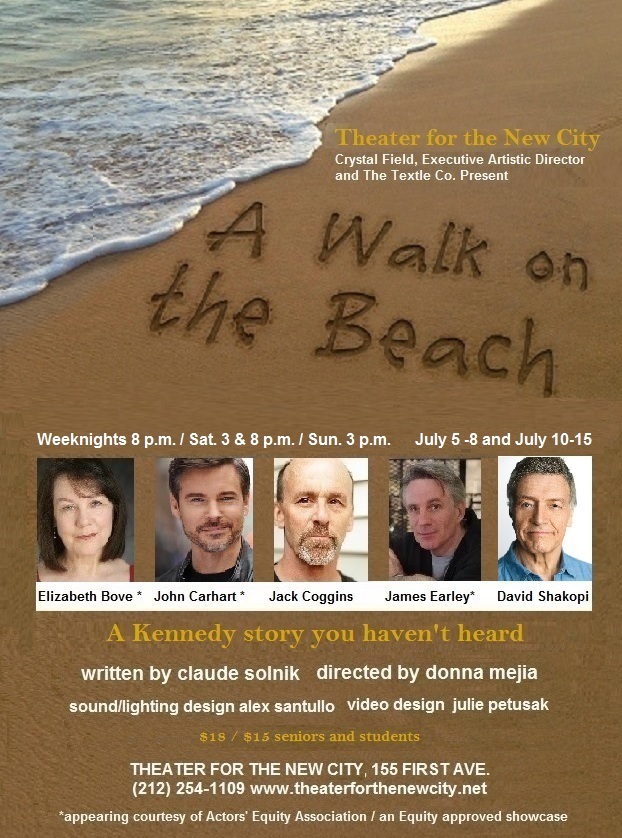A WALK ON THE BEACH Tells Story Of Controversial Kennedy Sculpture

Back in 2000, David Lewis, a sculptor in Cape Cod, designed a statue of John Fitzgerald Kennedy and his son John Jr. both as men walking on the beach.
The idea was to give the two a moment together that they never had and to give the Cape a beautiful work of art.
That's how the project was greeted initially complete with the support of Caroline and Ted Kennedy. Then something happened.
A controversy soon developed as a local paper championed the idea that this statue contradicted, even spit in the face of, history. Hyannisport needed art honoring history, some argued, not objects that were the result of an artist's or others' imagination.
A small model of the sculpture of the two Kennedeys as adults now stands in the John Fitzgerald Kennedy Museum in Hyannisport, but the life-sized statue never got made.
After the controversy essentially defeated the statue, Lewis made another sculpture of John Fitzgerald Kennedy walking alone on the beach. That statue stands in front of the JFK museum, providing a somewhat regal welcome to visitors.
The story of the statue that might have been and a conflict and controversy blending art, history, media, memory, imagination and the Kennedys briefly made news, appearing in Associated Press wire copy, television and publications. It is now the subject of a new play, at Theater for the New City.
Theater for the New City and the Textile Co. are presenting A Walk on the Beach, written by Claude Solnik and directed by Donna Mejia, Shows on weeknights are at 8 p.m. , Saturday at 3 p.m. and 8 p.m. and Sunday at 3 p.m. July 5-8 and July 10-15. Tickets are available at Theater for the New City at Tix.
Jack Coggins, an actor who grew up in Massachusetts and it turns out graduated from Harvard the same year as Caroline Kennedy, plays David Lewis.
Elizabeth Bove plays Nancy Lewis, John Carhart plays Charlie, a local editor, and David Shakopi plays Louis, a local restaurant owner.
"It's a story of art, media, Massachusetts, history, controversy, a small town and, of course, it's a Kennedy story," Solnik said.
David Lewis, who worked for many years as a plumber, then became a sculptor, specializing in historic figures. His creations stand in various locations around the Cape and elsewhere.
He designed the original statue, showing JFK as a man with "John John" or John Jr. as a child after John Jr.'s plane crashed. Lewis got the design to Sen. Ted Kennedy and Caroline Kennedy, showing a famous father and son.
"A friend of mine who's friendly with the senator saw it. He took two copies and showed one to Caroline and the senator," Lewis said of sketches of the original sculpture. "They liked the idea and that something should be done."
The two, however, didn't like the idea of freezing John Kennedy Jr. forever as a child, essentially ignoring much of his life.
"Caroline said that to depict him as a little boy would detract from his memory," Lewis said. "The senator said to our mutual friend, 'Why don't we have them both as men?'"
So the idea of this statue was born. A Walk on the Beach follows what occurred, telescoping it into a shorter time frame and creating a fictional figure to represent the local publication's role in stoking controversy.
The local publication ran numerous letters criticizing and opposing the statue as not true to history in what turned into a clash between imagination and memory, media and art.
"People couldn't wrap their minds around something artistic. I got reports like, 'Well, the president never knew his son as an adult,'" Lewis said. "I'm not comparing myself to Michelangelo. He did the Pieta. Mary holds her dead son in her lap and he's older than she is. They accepted that 500 years ago."
The statue was designed around 2000 - and the statue of JFK by himself went up in front of the museum in 2007.
Suffice it to say that at least briefly, however, a statue that started as a heartfelt tribute to the Kennedys was at the center of a controversy.
Claude Solnik, who wrote A Walk on the Beach, saw a small statue of the two Kennedys as men inside the JFK Museum. He then wrote something brief about the impact it had on him and sent it to the museum, which forwarded his writing to Lewis.
"I was able to talk with him. I didn't know he had designed the statue to be life-sized and that it was never fully realized, that the small sculpture in the museum was meant to be a model for something much larger," Solnik said. "I thought it was an incredibly powerful work of art. I was surprised to hear about the controversy and what occurred. And I thought there was a powerful story behind it."
Solnik said he was moved by the statue, spending a great deal of time simply standing in front of it when he visited the museum. After talking with David Lewis, he felt that the statue's story itself could fuel a play.
"I think the small model is one of the most moving works of art I've ever seen. It's about fatherhood, growing older with your son," Solnik said. "It's about a personal loss to the Kennedys, not just the loss to
the world, the fact that these two people never got to know each other as adults. They are a family and a father and son who never got to grow older together."
A Walk on the Beach, Theater for the New City, 155 First Ave., New York, NY. Weeknights at 8 p.m. Saturday at 3 p.m. and 8 p.m. and Sunday at 3 p.m. July 5-8 and July 10-15.Tickets $18/$15 seniors and students. 212-254-1109, www.theaterforthenewcity.net
Videos
